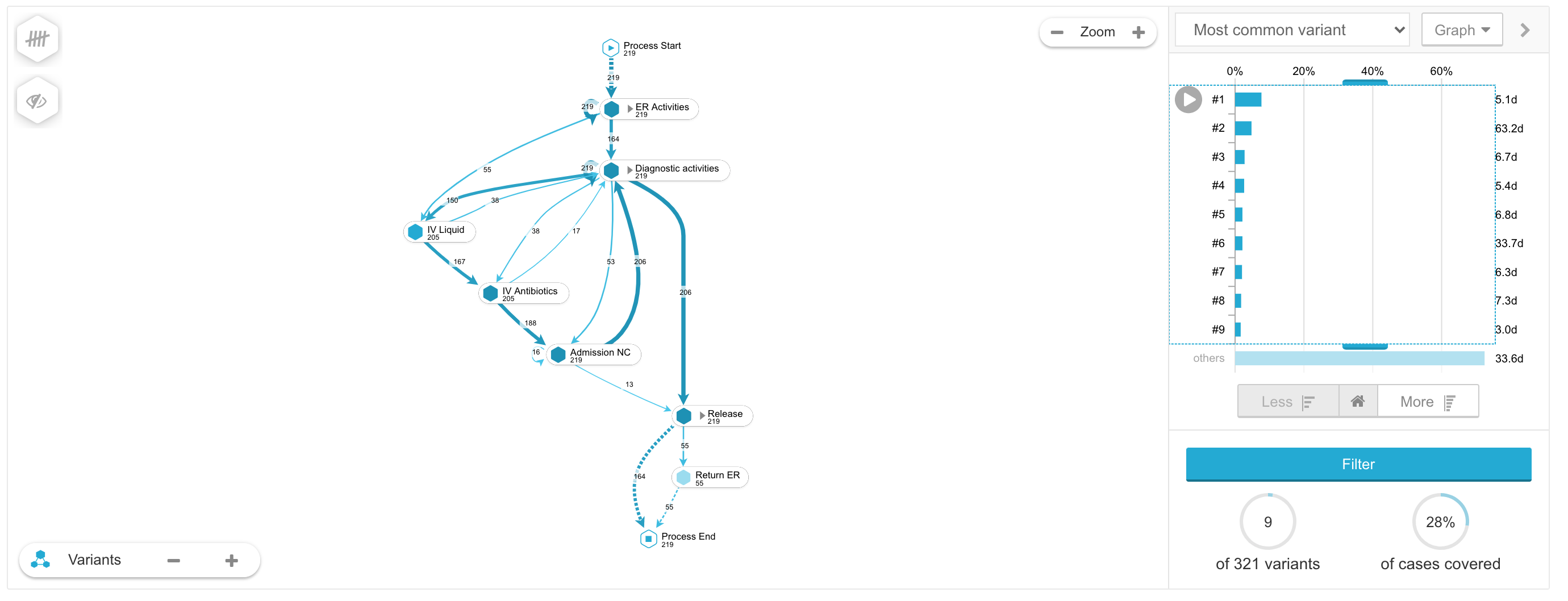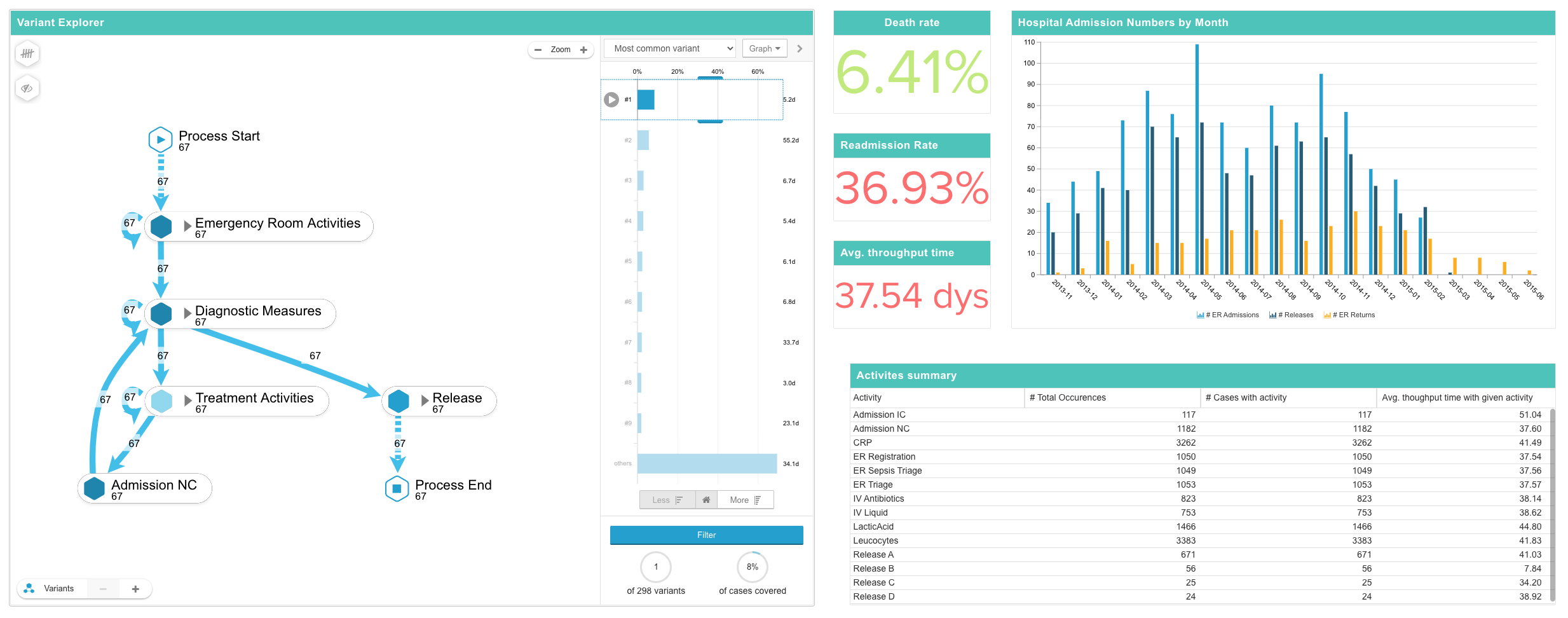Benefits of Process Mining for Hospitals
Hospitals face a challenging task of maintaining high levels of quality, timing, and functionality in treating patients while dealing with complex processes. To address hidden inefficiencies and costly mistakes, hospitals are turning to process mining. In this snap challenge, we take a closer look at sepsis emergency room (ER) admissions and their treatment. Sepsis is a life-threatening organ dysfunction that leads to an estimated 11 million sepsis-related deaths every year, with healthcare costs amounting to around $16.7 billion per year in the US alone. Through process mining, we can identify inefficiencies and risk groups to optimize existing capacities, reduce risks to patients, decrease administrative costs, and increase the hospital’s service level. Moreover, hospitals can continuously analyze new incoming data to identify new trends and violations for further actions.

tags
date
22 Oct 2020Intro
The main task of hospitals involves a patient’s diagnosis and the treatment of her/his problems. Maintaining high levels of quality, timing and functionality, becomes very difficult in the complex hospital environment. This makes process mining for hospitals an ideal approach to spot hidden inefficiencies, costly mistakes and optimise processes. In this snap challenge, we take a closer look at sepsis emergency room (ER) admissions and their treatment. Sepsis itself is a life-threatening organ dysfunction and an estimated 11 million sepsis-related deaths occur every year. Although most cases are found in low- and mid-income countries, still about 15% of total cases occur in developed countries. In the US for example the annual health care costs for sepsis amount to about $16.7 billion per year.
A first glance
The figure below shows a simplified version of the paths that patients take when admitted to the ER with sepsis. The triangle on the left of the activity indicates that the displayed activity is a group of activities, which we can expand by clicking on it.

Process mine for inefficiencies
This figures gives a comprehensive overview of the nature of paths patients take when arriving in an emergency room with sepsis. We can immediately see that 291 out of the all 1,050 patients considered are re-admitted to the hospital. This is a problem as it puts pressure on the capacity of the hospital and additional administrative tasks. The next figure displays a detailed analysis of that variant explorer. On the left, we can filter by specific process variants. The detailed view on the right side shows that emergency room admissions peak around May 2014. Applying a filter on that date we found that even though the death rate does not increase significantly, the re-admission rate increases by more about 13% to 49.48% as compared to total readmissions.
Analysis of inefficiencies
A reason could be that during peak months, more patients are released early. This makes room for new more severe cases. Although this may be a short-term solution, it increases the risks for a patient. An ER re-admission exposes him to further pathogens and will reduce future hospital capacity. Given the deadly nature of Sepsis, it is crucial for hospital management to optimize the usage of existing capacities. Filtering on process paths that include a re-admission, we observe an average of 89.0 days between the first and second admission to the ER. Even before process improvements, this helps the hospital plan. If they have an abnormally high rate of releases in a month for risk groups, they can expect another spike of cases in around 89 days. Avoiding spikes and capacity constraints will reduce the risk for patients, decreases administrative costs, and increases the hospital’s service level.

Risk groups
Yet, how do you identify risk groups? The great thing about process mining for hospitals is the ability to add contextual patient data. This allows us to filter on specific patient groups and identify possible risk groups that are e.g. more likely to be re-admitted than others. We made a visualization of this in the following figure. The right side offers diagnostic info and filters on tests or indicators. These allow us to discover how age, temperature, or death rates vary compared to the average patient. For ER readmissions, the average patient is older, has higher leucocytes levels, and a higher critical temperature. These patients should thus receive extra attention to see whether their admission cannot be avoided in the future.

Conformance checking
The last step in this analysis of process mining for hospitals is a conformance test. It allows us to compare the designed process with what really happens. We define key performance indicators (KPIs) that compare violations against the conforming cases. For this case, we defined throughput time and activities per case. As 28% of cases involve a return to the ER, a root-cause analysis could be useful and reducing them will have a beneficial financial impact. In California (US) alone, sepsis hospital readmissions amount to an annual estimated cost of $500 M. Thus, reducing this by 20% and assuming equal spread over the 344 hospitals in California, each can save on average $290,000 annually. Subsequently, a conformance check like this is key for identifying root causes and continuously monitoring them. You can find a simplified version of the conformance checker in the link at the end of this article.
Process automation and continuous improvement checking
All the above already gives a good overview of possible areas of improvement within a hospital-patient treatment process. By finding initial bottlenecks, inefficiencies and with the help of the AI-powered assistant, the hospital is able to continuously analyse new incoming data to spot e.g. new seasonal trends, dynamic changes in their processes, and novel violations. These can then act as triggers for further actions such as notifying the correct people or adjusting forecasts in other IT systems.
Process Mining with Apolix
This analysis shows interesting insights into processes mining for hospitals. As data specialists, we are here to help you on this journey. We support setting up initial analyses, educate your workforce, and offer strategic advice on your analytics strategy. Moreover, as data enthusiasts, we love to explore new opportunities to put your data to work – Are you curious about how process mining can make your organisation more efficient? We love to discuss this over an (online) coffee!





